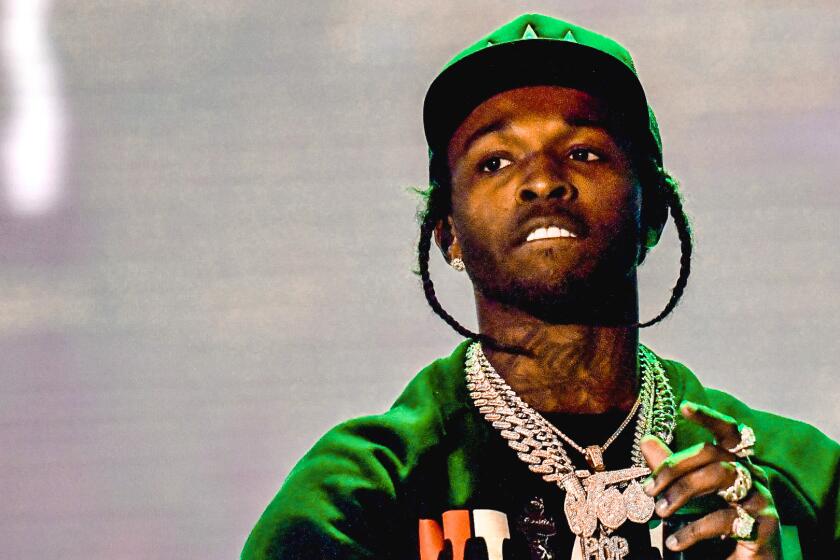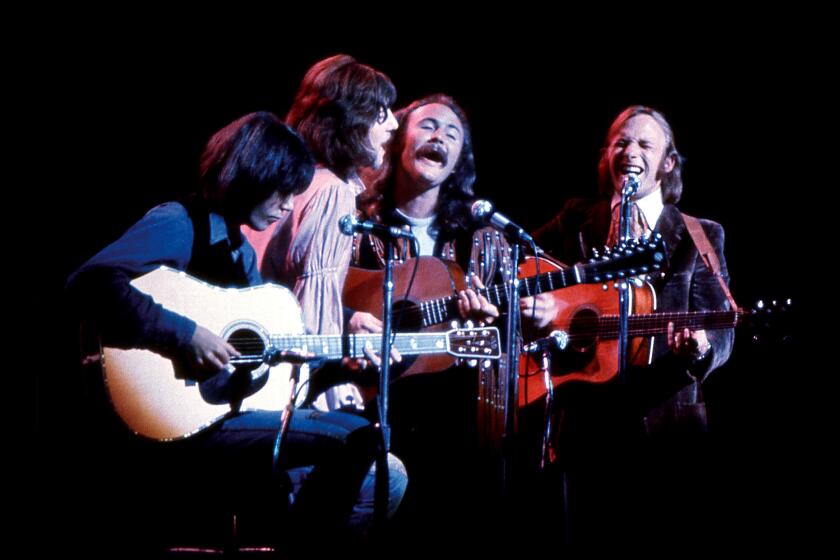What’s Pokemon? Just Ask Any Kid
- Share via
When Kenric Lo’s alarm goes off at 6:30 in the morning, he bolts from bed and hurriedly dresses for school. Minutes before 7 a.m., Kenric, age 10, plops in front of the TV, grabs the remote and zaps on his favorite cartoon show: “Pokemon.”
It’s a ritual taking place in many homes of young video game fans. Children who once slept through breakfast are up with the dawn to watch the weekday program--the cornerstone of Nintendo of America’s elaborate sales pitch for its Pokemon video game.
And thanks to the show--plus a relentless, nine-month publicity drive--Pokemon has become one of the hottest toys of the holiday season. Nintendo expects to sell a million Pokemon games by Dec. 31, making the $30 game for the hand-held Game Boy system as big an item as the much-hyped talking creature, Furby.
Electronics chains and toy stores are selling out entire Pokemon shipments on the day the games arrive. Best Buy has been handing out rain checks for Pokemon since mid-November.
“This is my fourth stop today,” said Sally Mendez, an exasperated parent who fruitlessly searched for the video game amid Pokemon playing cards, stickers and key chains at a gift shop in Orange. “Does anyone have it?”
Media critics blame the frenzy on a commercial assault in which the television show is little more than a 30-minute pitch for the video game.
“The show is on the air for the wrong reason,” said Peggy Charren, a longtime children’s television activist. “It doesn’t serve the public interest. . . . It serves the bottom line of the corporations involved.”
But marketers counter that kids are experts at seeing through hype; witness the amount of movie-related merchandise that ends up in discount bins.
“You can create all the hype you want,” says Ira Mayer, publisher of the New York-based trade publication Licensing Letter. “If the product doesn’t deliver, it’s gone.”
Since it went on sale Sept. 28, Pokemon has become Topic A in elementary schools. At least one middle school in Northern California has banned the game, in which players capture and train 150 miniature monsters. At an Arcadia playground one recent afternoon, three fifth-graders compared notes on the monsters they like best.
Donald Price, 10, tapes posters of Blastoise, a turtle-like creature, and other favorites on the closet door in his bedroom; he downloads the pictures from Nintendo’s Web site.
And his friend Kenric pastes his drawings of Pokemon monsters to his bedroom wall. Sometimes, Kenric says, he creates Pokeballs--empty spheres used in the video game to trap Pokemon--by crunching up sheets of paper and putting pictures of Pokemon monsters inside.
“I like the whole idea of the game,” says another friend, Dustin Gjeloshaj, 10. “I like the idea of collecting them, and trying to train them. It’s fun.”
Few toys have been launched as aggressively as Pokemon. Besides the TV show, there are licensed toys and collectibles (from Hasbro), a fast-food tie-in (with KFC), an in-school promotion (thousands of kids got free Pokemon book covers), a direct-mail blitz (1 million children received promotional videos), and a steady stream of TV commercials in which adorable children sing a spirited jingle.
Also in Nintendo’s arsenal is its own Nintendo Power magazine. Since April, each issue of the 650,000-circulation monthly has contained a colorful 32-page comic book about the adventures of Pokemon monsters and their human trainers.
Nintendo says it is spending $14 million to plug Pokemon, two to three times what it typically spends to promote a new game.
Industry observers say the reasons behind the blitz are no mystery.
“Think about the pure number. There are 150 monsters in a game,” said Howard Grossman, editor of Expert Gamer magazine. “If you think of that as a toy line, there are 150 separate toys you can sell.
“Granted, none will be as popular as Super Mario,” Grossman added, referring to Nintendo’s best-known video game character. “But that’s still a lot of little toys and key chains.”
It’s Major Hit at Home in Japan
Underlying Nintendo’s marketing assault is the success of Pokemon in Japan, where the popular 3-year-old toy has produced a treasure trove of spinoffs easily exported to the United States.
Pokemon comics already appear in six Japanese publications. More than 1,000 items--from clothes to books to toys--feature Pokemon monsters. And the Pokemon TV series--the same program that’s rousing American youngsters in the morning--is Japan’s highest-rated children’s show.
Last December more than 700 Japanese children went to hospitals with headaches and seizures blamed on flashing lights in one Pokemon TV episode. (The program was edited before being aired here.)
Even with a war chest of toys, comics and a TV series, Pokemon wasn’t a sure bet in the United States. In a category driven by speed and lifelike graphics, Pokemon, a black-and-white game for the technologically obsolete Game Boy system, didn’t measure up.
And many gaming industry observers considered Pokemon too mild for young American gamers, with their fondness for realistic video combat.
“It isn’t the hyper-kick-punch game associated with boys 12 to 14,” said Andy McNamara, an editor at Minnesota-based Game Informer magazine. “No one knew whether kids would jump all over this thing.
“I thought Pokemon could be a huge hit or an enormous bomb,” McNamara said.
Independent TV stations greeted the syndicated show coolly when Nintendo offered it last spring. Local broadcasters were skeptical of a series about an unfamiliar character that could strike out with kids--like Bandai America’s “Sailor Moon” show and toys did a few years ago.
But Nintendo persuaded dozens of stations to pick up the weekday show by committing a total of $5 million in advertising to them. Even with that, the Pokemon show was relegated to undesirable time slots in some markets, such as 6 a.m. in Fresno.
But the 30-minute animated program, in which a band of adventuresome children catch, train and nurture elusive Pokemon monsters, has been a ratings success. The distributor, New York-based 4 Kids Entertainment, boasts that Pokemon is the top-rated syndicated children’s program.
In Los Angeles, where it airs on KCOP Channel 13, Pokemon has stronger ratings in its half-hour time slot than “CBS Morning News” and is threatening ABC’s “Good Morning America.” And it has handily conquered “Hercules,” which airs opposite Pokemon on KCAL Channel 9.
“We’re very pleased with it,” said Joyce Inouye, KCOP’s research director.
Nintendo says two toy fads paved the way for Pokemon--the Tamagotchi virtual pet from Bandai America and Ty Inc.’s Beanie Babies stuffed animals. Pokemon monsters must be cared for to grow, just like the Tamagotchi pets so popular last Christmas. And, as with Beanie Babies, the object of Pokemon is to build a collection.
Children “being familiar with those crazes helped,” said Nintendo’s marketing vice president, George Harrison.
Nintendo heightened the collectible nature of Pokemon by creating two versions of the game, a red and a blue, with a handful of monsters unique to each. The only way kids can collect all 150 monsters is to use a device that allows trades between the red and blue versions.
Second Wave of Products Due
Nintendo says the gimmick is intended to encourage children to play together, but gaming industry watchers suspect some parents are buying both versions.
Marketers say the challenge for Nintendo lies beyond the holiday season. The company’s goal is to sustain the popularity of Pokemon for two to three years. That’s an eternity in the world of video games, where 80% to 90% of a game’s sales occur during the first 12 to 16 weeks.
Nintendo is preparing to fan excitement for Pokemon in the U.S. with a second wave of products from Japan.
Harrison said it’s likely Nintendo next fall will introduce Pokemon Stadium, a version that can be played on the Nintendo 64 console system.
And a Pokemon movie, currently Japan’s second-highest-grossing theatrical release, is likely to become available here on video in 1999, said Alfred R. Kahn, chief executive of 4 Kids Entertainment. That’s on top of a more extensive line of Pokemon toys being developed by Hasbro.
The way it looks now, Nintendo will find eager young buyers for all things Pokemon.
“I’m getting all the versions of Pokemon,” said Dustin Gjeloshaj, the Arcadia fifth-grader, who learned about them on the Internet. “Pokemon Stadium for [Nintendo 64]--I’m getting it when it comes out.”
(BEGIN TEXT OF INFOBOX / INFOGRAPHIC)
Atta Boy
Worldwide sales of Nintendo’s hand-held Game Boy systems declined steadily from their peak in 1992 until Nintendo took steps in 1996 to revive them. Software sales are experiencing a similar comeback. The Japan-based company now controls 80% of the hand-held video game business in the United States.
WORLDWIDE GAME BOY SALES In millions of units
Software: 34.6 million
Systems: 11 million
* Estimate
Source: Nintendo of America
More to Read
The biggest entertainment stories
Get our big stories about Hollywood, film, television, music, arts, culture and more right in your inbox as soon as they publish.
You may occasionally receive promotional content from the Los Angeles Times.










